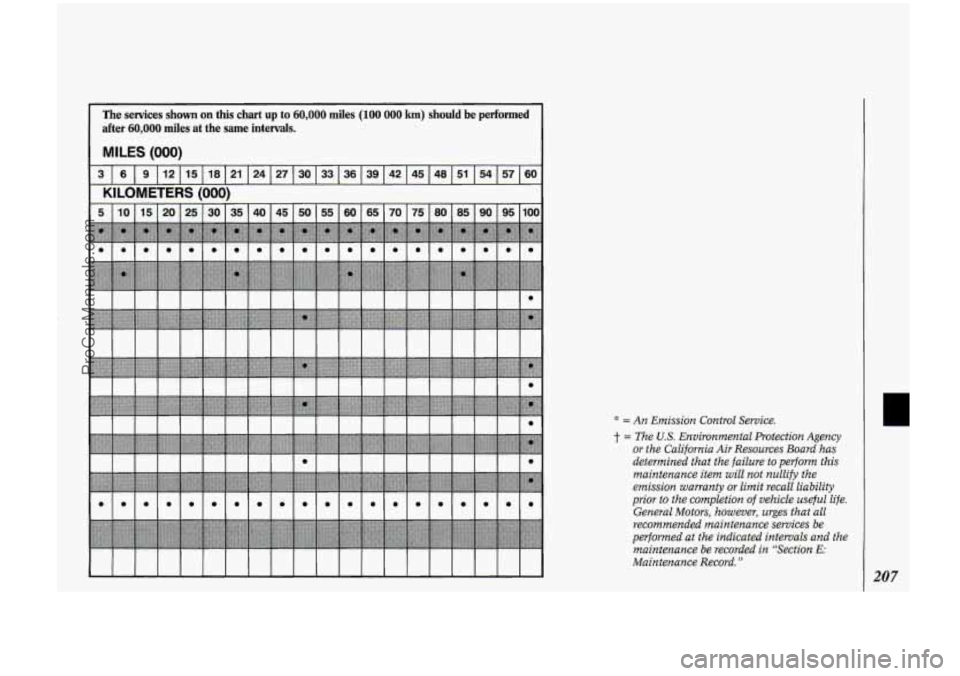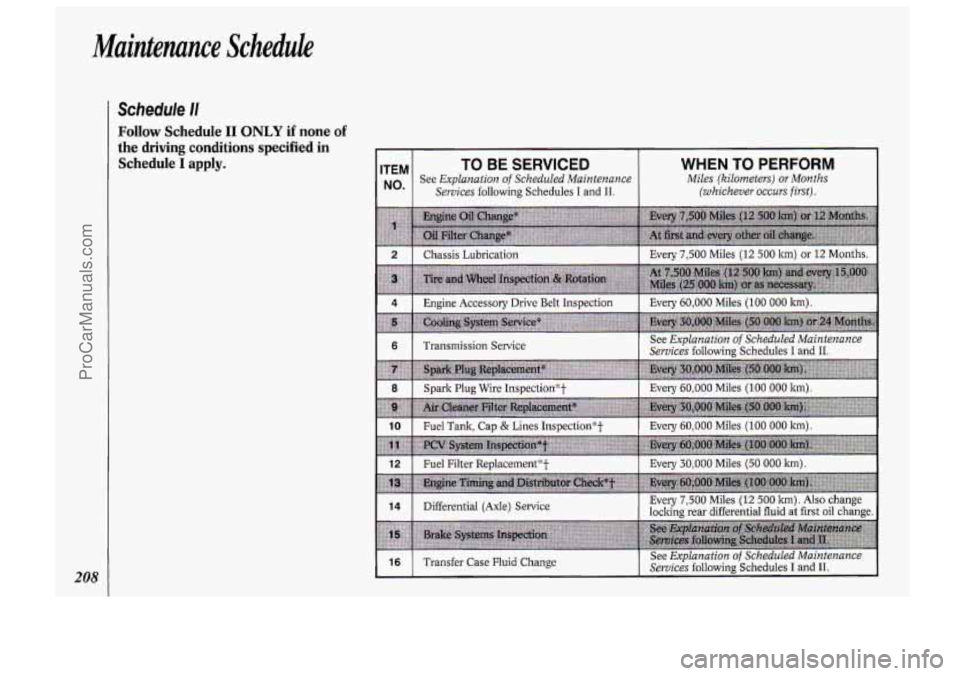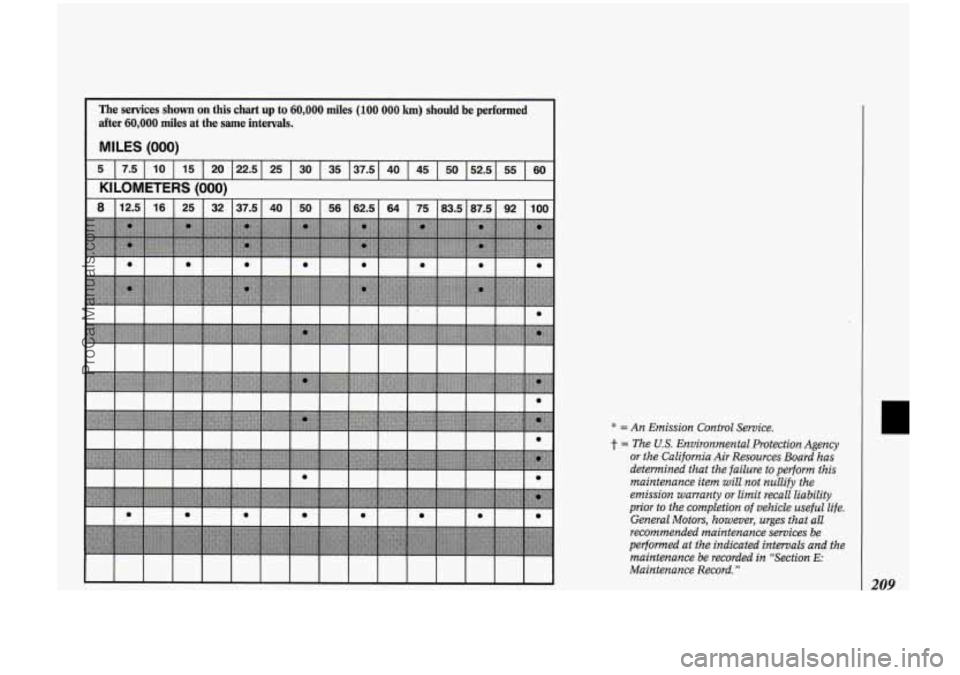OLDSMOBILE BRAVADA 1994 Owners Manual
Manufacturer: OLDSMOBILE, Model Year: 1994, Model line: BRAVADA, Model: OLDSMOBILE BRAVADA 1994Pages: 248, PDF Size: 14.54 MB
Page 211 of 248

“Section C: Periodic Maintenance
Inspections” explains important
inspections that your Oldsmobile
dealer’s service department or another
qualified service center should perform.
“Section
D: Recommended Fluids &
Lubricants” lists some products GM
recommends to help keep your vehicle
properly maintained. These products, or
their equivalents, should be used
whether you do the work yourself or
have it done.
“Section
E: Maintenance Record”
provides a place for you to record the
maintenance performed on your vehicle.
Whenever any maintenance is
performed, be sure to write it down in
this section.
This will help you
determine when your next maintenance
should be done. In addition, it is a good
idea to keep your maintenance receipts.
They may be needed to qualify your
vehicle for warranty repairs.
Section A: Scheduled
Maintenance Services
Using Your Maintenance
Schedules
This section tells you the maintenance
services you should have done and
when you should schedule them. Your
Oldsmobile dealer knows your vehicle
best and wants you to be happy with it.
If you go to your dealer for your service
needs, you’ll know that GM-trained and
supported service people will perform
the work using genuine GM parts.
These schedules are for vehicles that:
carry passengers and cargo within
recommended limits.
You will find
these limits
on your vehicle’s
Certificatioflire label. See the
Index
under Loading Your Vehicle.
are driven on reasonable road
surfaces within legal driving limits.
use the recommended unleaded fuel.
See the
Index under Fuel.
Selecting the Right Schedule
First you’ll need to decide which of the
two schedules is right for your vehicle.
Here’s how to decide which schedule to
follow:
Schedule I
Is any one of these true for your
vehicle?
Most trips are less than 4 miles (6
km) .
Most trips are less than 10 miles (16
km) when outside temperatures are
below freezing.
The engine is at low speed most of the
time (as in door-to-door delivery, or
in
stop-and-go traffic).
areas or off-road frequently.
You operate your vehicle in dusty
You tow a trailer.
If any one (or more) of these is true for
your driving, follow Schedule
I.
Schedule I1
Follow Schedule I1 only if none 01 me
above conditions is true.
L
205
ProCarManuals.com
Page 212 of 248

Maintenance Schedule
206
Schedule I
Follow Schedule I if your vehicle is
MAINLY driven under one or more of
the following conditions:
When most trips are less than 4 miles
When most trips are less than 10
(6 lun) .
miles (16 lm) and outside
temperatures remain below freezing.
When most trips include extended
idling and/or frequent low-speed
operation, as in stop-and-go traffic.
When towing a trailer.
When operating in dusty areas or off-
Schedule I should also be followed if
the vehicle is used for delivery service,
police, taxi or other commercial
applications.
road frequently.
ITEM TO BE SERVICED
Nom See Explanation of Scheduled Maintenance
Services
following Schedules I and 11.
WHEN TO PERFORM
Miles (kilometers) or Months
(whichever occurs first).
2 1 Chassis Lubrication 1 Everv 3.000 Miles (5 000 kml or 12 Months. I
4 I Engine Accessory Drive Belt Inspection (erv 60.000 Miles (100 000 kml. I
6 I Transmission Service See Explanation
of Scheduled Maintenance
Services
following Schedules I and 11. I
8 I Spark Plug Wire 1nspection"t I Every 60,000 Miles (100 000 lm). I
10 I Fuel Tank, Cap & Lines Inspection*t I000 Miles (100 000 lun). I
12 I Fuel Filter Replacement*t I Everv 30.000 Miles (50 000 lun). I
16 I Transfer Case Fluid Change I See Explanation of Scheduled Maintenance
Services
followinrr Schedules I and 11. I
ProCarManuals.com
Page 213 of 248

The services shown on this chart up to 60,000 miles (100 000 km) should be performed
after
60,000 miles at the same intervals.
MILES (000)
KILOMETERS (000)
3 60 57
54
51
48
45 42 39 36
33
30 27 24
21 18
15
12 9
6
IIIIIIIIIIIIIIIIIIIII
* = An Emission Control Service.
t = The U.S. Environmental Protection Agency
or the California Air Resources Board has
determined that the failure to perform this
maintenance item will not nullify the
emission warranty
or limit recall liability
prior to the completion
of vehicle useful life.
General Motors, however, urges
that all
recommended maintenance services be
performed at the indicated intervals and the
maintenance be recorded in “Section
E:
Maintenance Record. ”
207
ProCarManuals.com
Page 214 of 248

Schedule I/
Follow Schedule I1 ONLY if none of
the driving conditions specified in
Schedule
I apply. ITEM TO BE SERVICED
No' See Explanation of Scheduled Maintenance
Services
following Schedules I and 11.
WHEN TO PERFORM
Miles (kilometers) or Months
(whichever occurs first).
I Every 60,000 Miles (100 000 km). I
I 10 I Fuel Tank, CaD & Lines Inspection*t I Every 60,000 Miles (100 000 km). I
I 16 1 Transfer Case Fluid Change
~~ I See Explanation of Scheduled Maintenance
Services
following Schedules I and 11. I
ProCarManuals.com
Page 215 of 248

IIIIIIIIIIIIIIIII
* =An Emission Control Service.
t = The US. Environmental Protection Agency
or the California Air Resources Board has
determined that the failure to perform this
maintenance item will not nullify the
emission warranty
or limit recall liability
prior to the completion of vehicle useful life.
General Motors, however, urges that all
recommended maintenance services be
performed at the indicated intervals and the
maintenance be recorded in “Section
E:
Maintenance Record. ’’
II I
209
ProCarManuals.com
Page 216 of 248

210
Explanation of Scheduled
Maintenance Services
Below are explanations of the services
listed in Schedule I and Schedule 11.
The proper fluids and lubricants to use
are listed in Section
D. Make sure
whoever services your vehicle uses
these. All parts should be replaced and
all necessary repairs done before you or
anyone else drives the vehicle.
ITEM SERVICE
NO.
1. Engine Oil and Filter Change* -
Always use SH or SG Energy
Conserving I1 oils of proper viscosity.
The
“SH” or “SG” designation may be
shown alone or in combination with
others, such as “SH/CD,”
“SH, SG,
CD,” “SG/CD,” etc. To determine the
preferred viscosity for your vehicle’s engine (e.g., SAE 5W-30 or SAE 1OW-
30), see the Index under Engine Oil.
2. Chassis Lubrication - Lubricate the
transmission shift linkage, parking
brake cable guides, underbody contact points and linkage. Lubricate the front
suspension and steering linkage.
3. Tire and Wheel Rotation and
Inspection
- For proper wear and
maximum tire life, rotate your tires
following the instructions
in this
manual. See
Tires, Inspection G.
Rotation in the Index. Check the
tires for uneven wear or damage. If
you see irregular or premature wear,
check the wheel alignment. Check for
damaged wheels also.
Inspection - Inspect the drive belt
for cracks, fraying, wear and proper
tension. Replace as needed.
5. Cooling System Service‘: - Drain,
flush and refill the system with new
or approved recycled coolant
conforming to
GM Specification
6038-M. Keep coolant at the proper
mixture as specified. See
CooZant in
the
Index. This provides proper
freeze and boil protection, corrosion
inhibitor level and maintains proper
engine operating temperature.
Inspect hoses and replace if they are
cracked, swollen or deteriorated.
Tighten screw-type hose clamps. Clean the outside of the radiator and
air conditioning condenser. Wash the
pressure cap and neck.
4. Engine Accessory Drive Belt
To help ensure proper operation, we
recommend
a pressure test of both the
cooling system and the pressure cap.
6. Transmission Service - Change
both the fluid and filter every 15,000
miles
(25 000 lun) if the vehicle is
mainly driven under one or more of
these conditions:
In heavy city traffic where the
outside temperature regularly
reaches
90°F (32°C) or higher.
In hilly or mountainous terrain.
When doing frequent trailer towing.
Uses such as found in taxi, police
If you do not use your vehicle under
any of these conditions, change both
the fluid and filter every
100,000
miles (166 000 lun) .
Replace spark plugs with the proper
type. See
Replacement Parts in the
Index.
8. Spark Plug Wire Inspection‘%t -
Inspect for burns, cracks or other
damage. Check the boot
fit at the
coils and at the spark plugs. Replace
wires as needed.
car
or delivery service.
7. Spark Plug Replacement” -
ProCarManuals.com
Page 217 of 248

9. Air Cleaner Filter Replacement': -
Replace every 30,000 miles (50 000
km) or more often under dusty
conditions. Ask your dealer for the
proper replacement intervals for your
driving conditions.
10. Fuel Tank, Cap and Lines
Inspection*t
- Inspect fuel tank,
cap and lines (including fuel rails
and injection assembly) for damage
or leaks. Inspect fuel cap gasket for
an even filler neck imprint or any
damage. Replace parts as needed.
1 1. Positive Crankcase Ventilation
(PCV) System 1nspection':t
-
Inspect the system for proper
function. Replace any worn, plugged
or collapsed hoses and seals.
Replace valve only if necessary.
12. Fuel Filter Replacement'$t -
Replace the fuel filter every 30,000
miles (50 000 ltrn), or sooner if
clogged.
13. Engine Timing and Distributor Check':'t
- Adjust the timing to
the underhood label specifications.
Inspect the inside and outside of the
distributor cap and rotor for craclts, carbon tracking and corrosion.
Clean or replace
as needed.
14. Differential (Axle) Service-Check
rear/front differential fluid level and
add as needed. Check constant
velocity joints and axle seals for
leaking.
Locking Rear Differential -Drain
fluid at first engine oil change and
refill. Check fluid level and add as
needed at subsequent oil changes. In
dusty areas, or trailer towing
applications, drain fluid at every
15,000 miles (25 000 ltm) and refill.
More frequent lubrication may be
required during heavy-duty or off-
road use. A fluid loss in this system
may indicate
a problem. Have it
inspected and repaired at once.
15. Brake Systems Inspection-When
the engine oil is changed, inspect
the lines and hoses for proper
hookup, binding, leaks, craclts,
chafing, etc. Check the parking
brake adjustment and the fluid level
in the master cylinder. A low brake
fluid level can indicate worn disc
brake pads which may need to be
serviced.
A fluid loss in this system may indicate a problem. See
the
Index under Brake System Warning
Light. When the wheels are
removed for rotation, inspect disc
brake pads for wear and rotors for
surface condition. Also inspect
drum brake linings for wear and
craclts. Inspect other brake parts,
including drums, wheel cylinders,
calipers, parking brake, etc. at the
same time.
You may need to have your brakes
inspected more often
if your driving
habits or conditions result in
frequent braking.
16. Transfer Case Fluid Change -In
heavy or frequent trailer towing
applications, drain fluid and refill
every
30,000 miles (50 000 ltm).
'$ = An Emission Control Service.
f = The US. Environmental Protection Agency
or the California Air Resources Board has
determined that the failure to pelform this
maintenance item will not nullify the
emission warranty or limit recall liability
prior
to the completion of vehicle useful life.
General Motors, however, urges that
all
recommended maintenance services be
performed at the indicated intervals and the
maintenance be recorded
in "Section E:
Maintenance Record. ''
211
ProCarManuals.com
Page 218 of 248

Maintenunce Schedule
212
4 Section B: Owner Checks and Services
Listed below are owner checks and services which should be performed at the intervals specified to help ensure the safety,
dependability and emission control performance of your vehicle.
Be sure any necessary repairs are completed at once. Whenever any fluids or lubricants are added to your vehicle, make sure
they are the proper ones, as shown in Section
D.
At Each Fuel Fill (/t is important for you or a service station attendant to perform these underhood checks at each fuel fi//-)
CHECK
OR SERVICE WHAT TO DO
Engine Oil Level
Check
the engine oil level and add the proper oil if necessary. See Engine Oil in the Index for
further details.
Engine Index for further details.
Windshield Washer Check the windshield washer fluid level in the windshield washer tank and add the proper fluid if
Fluid Level necessary. See
WindshieZd Washer Fluid in the Index for further details.
Check
the engine coolant level and add the proper coolant mix
if necessary. See CooZant in the
Least Once a Month
CHECK
OR SERVICE
I WHAT TO DO
Tire Inflation Check
tire inflation. Make sure they are inflated to the pressures specified on the Certification/
Tire label located on the rear edge of the driver’s door. See Tires in the Index for further details.
Cassette Deck Clean
cassette deck. Cleaning should be done every
15 hours of tape play. See Audio Systems in
the
Index for further details.
ProCarManuals.com
Page 219 of 248

At Least Once a Year
CHECK
OR SERVICE
Key Lock Cylinders
Body Lubrication
Starter Switch
Steering Column
Lock
WHAT TO DO
Lubricate the key lock cylinders with the lubricant specified in Section D.
Lubricate all body door hinges including the tailgate. Also lubricate all hinges and latches,
including those for the hood, rear compartment, glove box door, console door and any folding
seat hardware. Section
D tells you what to use.
CAUTION When you are doing this check, the vehicle could move suddenly\
. If it does, you
or others could be injured. Follow the steps below.
1, Before you start, be sure you have enough room around the vehicle.
2. Firmly apply both the parking brake (see Parking Brake in the Index if necessary) and the
NOTE: Do not use the accelerator pedal, and be ready to turn off the engine immediately if it starts.
3. Try to start the engine in each gear. The starter should work only in P (Park) or N (Neutral). If
regular
brake.
the starter works in any other position, your vehicle needs service.
While parked, and with the parking brake set, try to turn the key to
LOCK in each shift lever
position.
The key should turn to LOCK only when the shift lever is in P (Park).
The key should come out only in LOCK.
213
ProCarManuals.com
Page 220 of 248

Maintenance Schedule
214
At Least Once a Year (cant.)
CHECK
OR SERVICE
Parking Brake
and Automatic
Transmission
P (Park)
Mechanism Check
Underbody Flushing
Differential Service
Transfer Case
WHAT TO DO
CAUTION: When you are doing this check, your vehicle could begin to move. You or others
could be injured and property could be damaged. Make sure ther\
e is room in front
of your
vehicle in case it begins
to roll. Be ready to apply the regular brake at once should the vehicle
begin to move.
Park on a fairly steep hill, with the vehicle facing downhill. Keeping your foot on the regular
brake, set the parking brake.
To check the parking brake: With the engine running and transmission in N (Neutral), slowly
remove foot pressure
from the regular brake pedal. Do this until the vehicle is held by the
parking brake only.
To check the P (Park) mechanism's holding ability: Shift to P (Park). Then release all brakes.
At least every spring, use plain water to flush any corrosive materials from the underbody. Take
care to clean thoroughly any areas where mud and other debris can collect.
Check rear/front differential fluid level and add as needed. Check constant velocity joints and
axle seals for leaking.
Check transfer case fluid level. Check vent hose at transfer case for ltinlts and proper installation.
More frequent lubrication may be required on heavy-duty off-road use.
A fluid loss may indicate a
problem. Have it inspected and repaired
at once.
ProCarManuals.com